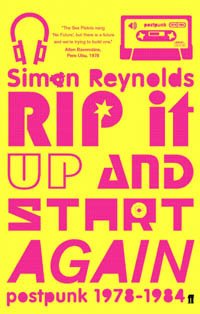
The best new book about contemporary music history I've read is Rip it Up and Start Again: postpunk 1978-1984 by British music journalist, Simon Reynolds. Arguably the most exciting time in music since the late sixties, the postpunk era finally gets its due. This near complete version of postpunk independent music and how the subsequent labels, distribution methods and venues to deliver the new sounds came about (--and were gradually devoured by major labels and each other). This is a book that had to come out. This kind of music was only available for such a brief period of time before being trampled underfoot by a horde of commercially produced imitators. This is the music created by the generation that came of age in the mid-seventies. The sounds created were so new that independent methods were the only way to communicate their existence. People deliberately eschewed courting major labels in the name of having absolute control over their music. Reynolds chronicles all the successes and failures of the most consistently inventive (both sonically and visually) group of young artists and businessmen that tried to make a lasting impact on modern life.
To a certain extent, the simultaneous movements on both sides of the Atlantic (the book primarily deals with the United Kingdom and the United States-- deliberately leaving the project open for companion works discussing similar activity in Europe, Canada, Latin America and Japan) have left their mark on what passes for culture today. The timing of the book's release could not be more welcome, as a number of the labels mentioned recently celebrated anniversaries (Rough Trade, Mute and Les Disques du Crepuscule, among others) while primarily re-issue labels like James Neiss's Les Temps Modernes (LTM) have made a bulk of the long deleted music metioned in the book available to a wider audience. (The most recent of which being the double disc compilation of Eric Random's work titledSubliminal 1980-1982.)
Apart from filling in the gaps of my education in this expansive and somewhat personal study, this book helps to show the relationships between the people involved in the culture industry at that time. The book is really about a network for the production and dissemination of culture, that presented a near viable alternative to current methods of perception. It is not just about the artists and musicians involved but also the contributions of the label owners, journalists, and the public. Shifts in taste, budget, politics, and -- to a large extent -- technology, acted to create a unique cultural product. The emergence of so many young artists into the cultural arena at that time was astounding. A record label, such as Manchester based Factory Records was hyper-conscious not only of the quality of the music but also its packaging, often delaying releases for weeks so its delivery could achieve visual perfection. The goal amongst all these labels was to craft a--whether conscious or not--brand identity, to manipulate the public into the fold. This created a wonderfully red-hot tension between the musicians, the labels and the public resulting in the furious activity this book describes. It is this same commitment to quality and artistic integrity that fans of this period discuss to this day with the intensity of an erotic fever-dream.
Multiple criticisms can be leveled against the writer for spending too much time on certain groups and not enough time on others. While this is a valid concern, I do not see any glaring omissions in this work. This book is not only for anyone who wants to know about certain bands but it is also for those who want to understand the systems of interaction between the events discussed and how so many disparate elements influenced each other. In doing so, it provides a survey of the influential acts of the period.
One must never forget the lessons learned here of how it can be done. Applying these notions today one immediately sees distribution methods rapidly changing by the hour. Radio is still primarily dominated by commercial programming (check stopcbcpop for a current example of this). The template created by college radio in the United States (there is no such thing as an "independent music chart" in the United States--not to mention the absolute absence of a ministry of culture.) has been modified and turned into so-called alternative programming on commercial stations after someone recoginzed the viability of this demographic (circa mid-1980s). Today, the market is even further entrenched in this petty commercialism.
Then again, the knife cuts both ways, new independent labels are born daily. Nearly everyone involved in culture has a website or e-mail as technology enables things to change yet again. Disenchanted consumers of fine music are able to trace cultural activities that were previously inaccessible. In this sense, "Rip it Up and Start Again" is a worthy reference to the early days when it was all done via telephone, SNAIL mail, live performances and radio programmes (today, one is tempted to add music blogs to that list).
Our culture is on the mend, we desperately need free thinking creative people to wake up the underground once again.
XXXXXXXXXXXXXXXXXXXXX
Rip it Up and Start again
by Simon Reynolds
ISBN: 0 571 21569 6
Format: Paperback
Published: April 21, 2005
Pages: 608pp
Price: £16.99
Also due for publication in USA late January/early February 2006.
check out Simon's blog in the meantime.



No comments:
Post a Comment